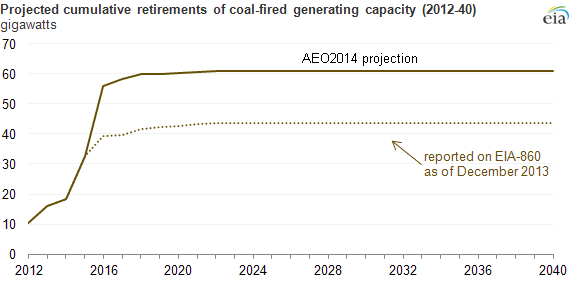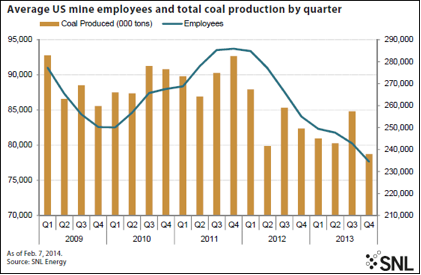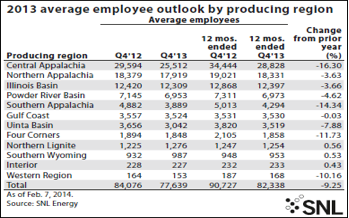“So, if somebody wants to build a coal plant, they can – it’s just that it will bankrupt them.” President Obama, 2008
The Energy Information Administration (EIA) is forecasting an increase in the number of coal-fired plants that will be prematurely retired due to onerous regulations by the Environmental Protection Agency (EPA). In 2008, then-Presidential candidate Obama said that if he were elected, any company that wanted to build a coal-fired plant could do so, but it would bankrupt them.[i] The President’s Administration, however, has gone further than to simply make impossible the construction of new coal-fired plants; its regulations are in fact already depleting the current inventory of coal-fired plants that have supplied as much as 50 percent of our nation’s electricity. The Administration should be paying attention because it was coal power that kept the lights and heat on this winter as extreme weather conditions resulted in an escalation in natural gas prices and as wind energy could not produce power when it was needed most.[ii] The intent of the Administration is becoming clear– to force higher electricity prices on the country through its policies on regulating fossil fuels while forcing more and more subsidized and intermittent renewable energy on an already unstabilized electrical grid. The consequences of these policies will be made clear to Americans in the future due to the likelihood that natural gas prices will not remain low forever. The combination of policies is the perfect recipe for a future of skyrocketing electricity prices, just as he also said in 2008.
Expected Coal Plant Retirements
EIA obtains data from electric utilities about their plans for retirement of their units. In the summer of 2012, EIA reported 27 gigawatts of coal-fired plant retirements through 2016.[iii] As of December 2013, reported retirements of coal-fired power plants by electric utility companies have grown to over 40 gigawatts.[iv] But, the EIA forecasters believe that the number of coal-fired retirements will be higher at 60 gigawatts, about 20 percent of the 310 gigawatts of coal-fired capacity that was operating in 2012. Ninety percent of those retirements are expected to occur by 2016, coinciding with the first year of enforcement for EPA’s Mercury and Air Toxics Standards.
Source: Energy Information Administration, http://www.eia.gov/todayinenergy/detail.cfm?id=15031
The EPA Regulations
The Mercury and Air Toxics Standards (MATS) require significant reductions in emissions of mercury, acid gases, and toxic metals. The standards are scheduled to take effect in April 2015, but can be conditionally extended by one year by state environmental permitting agencies. To comply with MATS, coal-fired plants must have flue gas desulfurization equipment (scrubbers) or dry sorbent injection systems installed by 2016. If it is too costly for a coal-fired power plant to add this expensive equipment, the plant must retire. It should be noted that, according to EPA, the benefits of reducing mercury and air toxics total $500,000 a year, but the rule costs $9.6 billion a year.
According to EIA, the first units to retire over the past 3 years were small and inefficient coal plants. But, the coal units expected to retire over the next several years are larger and more efficient, making the effects on the power sector of these retirements much more significant. In fact, the independent system operator in New England noted that reliability of the electric grid would be affected, as the amount of capacity that it needs in the near future falls short of what electric utility companies indicate they will have.[v] The United States is not accustomed to an electrical system that does not respond to consumers’ demands as evidenced by the large public outcry whenever there is a system outage due to weather events or accidents. It is not clear what the public response might be to a systemic and systematic shortage due to government policies and apparent design.
Coal Industry Job Losses
According to EIA data, coal-fired generation declined from almost 50 percent of the electricity market in 2008 to as low as 37 percent in 2012 due to competition from low natural gas prices and EPA regulations. With its major consuming sector reducing demand, coal production declined by 15 percent between 2008 and 2013. Along with the production declines, average coal mine employment fell as well. According to the U.S. Mine Safety and Health Administration, the average number of coal mine employees in 2013 fell by almost 10 percent from 2012 levels, to 82,338 employees. In the fourth quarter of 2013, the average number of coal mine employees was lower at 77,639, the lowest level since the first quarter of 2009. Between the fourth quarter of 2011 and the fourth quarter of 2013, average coal mine employment dropped by over 17 percent.[vi]
Source: SNL Energy, http://www.snl.com/InteractiveX/Article.aspx?cdid=A-26821238-1259
The numbers are even starker for some regions. In the Central Appalachian region, coal employment is down to 28,828 average employees in 2013, a 16.3 percent drop from 2012. In Southern Appalachia, coal employment declined by 14.3 percent in 2013. In Northern Appalachia, employment numbers were slightly better, outperforming the U.S. average decline in coal jobs with only a 3.6 percent drop in average coal jobs from 2012 to 2013.
The Powder River and Illinois basins had more moderate declines in average annual coal mine employment in 2013 than Appalachia. In the Powder River Basin, employment declined by 4.6 percent from 2012 levels to 6,973 average coal mine jobs in 2013. Coal mine employment in the Illinois Basin declined 3.7 percent, falling to 12,397 in the same period.
Source: SNL Energy, http://www.snl.com/InteractiveX/Article.aspx?cdid=A-26821238-1259
Other Sources of Power
While coal units are being retired, natural gas and renewable (wind and solar) generating units are being added. While low natural gas fuel prices have made natural gas generation less expensive than coal-fired generation, those natural gas prices are not expected to remain that low in the future. In EIA’s Annual Energy Outlook 2014, natural gas spot prices increase at an average annual rate of 3.7 percent in real terms (5.6 percent in nominal terms) between 2012 and 2040.
Wind and solar power have grown over the last several years, generating 3.6 percent of the nation’s electricity in 2012. According to EIA, wind generation costs 32 percent more than gas-fired generation and solar photovoltaic generation is 120 percent more expensive. Because of their higher cost, the renewable industry is dependent on federal subsidies and state mandates.
More Regulations to Come
Last month, the Environmental Protection Agency issued its proposed rule limiting carbon emissions on new power plants. The rule limits carbon dioxide emissions from new coal plants to 1,100 pounds per megawatt-hour, although the average current coal-fired power plant emits close to 1,800 pounds. The EPA justifies these numbers by suggesting that new coal-fired plants can meet the limit by installing carbon capture and sequestration technology. However, that technology is not commercially available, meaning no new coal-fired plants will be built.[vii] It is expected that regulations with a similar effect will be imposed on existing coal-fired plants by EPA in the future.
EPA Working with Environmental Groups
A Freedom of Information Act request showed top EPA officials have collaborated with anti-coal environmentalist groups (e.g. Sierra Club and Natural Resource Defense Council) via internal communications. According to the emails, EPA officials helped the environmental groups gather petition signatures that support regulations which would impose large costs on coal-fired power plants and place a de facto moratorium on the construction of new coal plants. The emails also showed that the environmentalist groups advised EPA on where to hold public hearings on the regulations, which were far from the nation’s most coal-intensive regions–the regions that will see a dramatic decline in employment as a result of those regulations.[viii]
Coal workers recognize the political factors. Ethan McGrew, a coal miner laid off in December 2012 when Consol Energy shut down a West Virginia mine, said “My human resource guy, before we shut down, told us our future in coal, working underground, would depend on the 2012 presidential election. My dad was a coal miner and he lost his job back in 2008. He lost his job in the first presidential election, the second election came around, and I ended up losing my job.”[ix]
Conclusion
Announced coal-fired power plant retirements are up because EPA regulations requiring expensive equipment to meet its onerous regulations make the plants uneconomic. However, the extreme cold weather this winter has shown that the nation needs those plants to ensure reliability. With their retirement and competition from low cost natural gas, coal-fired generation has taken a major downturn, reducing coal production, and causing coal miners to lose their jobs. Regardless, the EPA continues with its onerous regulations that internal communications have shown came from a collaboration of anti-coal environmental groups and top EPA officials.
The future integrity of our electrical system and the affordable electricity Americans have become accustomed to is being called into question by disparate impacts and policies. The problems are already being felt, but the future challenges resulting from the fundamental transformation of our energy delivery system have yet to be seen and they are substantial.
[i] Washington Times, Chance to block Obama’s war on coal, June 19, 2012, http://www.washingtontimes.com/news/2012/jun/19/chance-to-block-obamas-war-on-coal/
[ii] The Hill, Utilities turn to coal as cold blast spikes natural gas prices, February 13, 2014, http://thehill.com/blogs/e2-wire/e2-wire/198327-utilities-turn-to-coal-as-cold-blast-spikes-natural-gas-prices#ixzz2tGVM627F
[iii] Energy Information Administration, 27 gigawatts of coal-fired capacity to retire over next five years, http://www.eia.gov/todayinenergy/detail.cfm?id=7290
[v] Greenwire, Nuclear giants urge market changes to thwart closures, February 6, 2014,http://www.eenews.net/greenwire/stories/1059994177/search?keyword=Nuclear+giants+urge+market+changes+to+thwart+closures
[vi] SNL Energy, US coal mine employment continues to plummet with no bottom in sight, February 13, 2014, http://www.snl.com/InteractiveX/Article.aspx?cdid=A-26821238-12590
[vii] Wall Street Journal, How to Fight the Unilateral President, February 17, 2014, http://online.wsj.com/news/articles/SB10001424052702304302704579335073537509410?mod=rss_opinion_main
[viii] Free Beacon, Emails Show Extensive Collaboration Between EPA, Environmental Orgs, January 15, 2014, http://freebeacon.com/emails-show-extensive-collaboration-between-epa-environmentalist-orgs/
[ix] Free Beacon, Coal Power Plant Shutdowns to Accelerate, February 14, 2014, http://freebeacon.com/report-coal-power-plant-shutdowns-to-accelerate/






